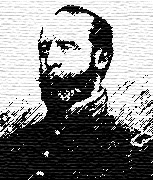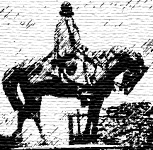THE OSBORNE FAMILY:
An Inventory of Papers in Syracuse University Libraries©
DESCRIPTION OF COLLECTION
 | NYCHS
Excerpts
Presentation
Page 9 of 14 |
The Osborne Family Papers consist of correspondence and the records of the Osborne family and related branches of Coffin, Devens, Garrison, Harris, Mott, Pelham, Storrow, and Yarnall families. The bulk dates of the papers are 1812-1968, with a concentration in the period 1880-1925.
Auburn, New York, has been the Osborne family home since the early 19th century. Relatives whose correspondence is represented among the papers also resided in Boston, and Springfield, Mass., and Philadelphia, Penn.
Genealogical charts have been prepared . . . while they are not meant to be comprehensive, the charts will assist in identifying members who figure prominently in the correspondence.
 | |
Civil War General and U.S. Attorney General Charles Devens (depicted in sketch above) was Thomas Mott Osborne's granduncle; that is, his maternal grandfather's brother. Putting it another way: Charles Devens was the uncle of TMO's mother, Agnes.
A Harvard law graduate (1840), Charles Devens practiced law from 1841 to 1849 in Mass. and served as a State Senator (1848 - 1849). From 1849 until 1853 he served as U.S. Marshal. In 1854 he resumed the practice of law in Worcester.
During the Civil War, Devens served as a rifles battalion major, rose to colonel of the 15th Mass. Volunteers, was promoted brigadier general and brevet major general, was wounded at Fair Oaks and Chancellorsville, and mustered out in 1866.
In 1867, Devens was appointed Superior Court Justice and in 1873 a State Supreme Court Justice. On March 12, 1877, he was appointed U.S. Attorney General by President Hayes. In 1881 Devens was reappointed Mass. Supreme Court Justice. He died in Boston on Jan. 7, 1891.
An interesting and revealing aspect of his federal service involved a fugitive slave named Sims. Appointed U.S. Marshal by President Fillmore, it became his duty to execute the process under which Sims had to be returned to his owner. But when Devens became U.S. Attorney General a quarter century later, he appointed Sims to a position in the Department of Justice.
In front of the Worcester Courthouse, a statue of Union Gen. Charles Devens, astride a horse (depicted in sketch below), was unveiled on July 4, 1906 by sculptor Daniel Chester French. Another statue --a heroic size bronze by sculptor Olin L. Warner -- was erected to his memory on the state house grounds in Boston.
For more on Gen. Charles Devens, visit Susan L. Harnwell's 15th MVI site and find his bio link in the 15th MVI bios A to E.
[Image selection & caption by NYCHS webmaster]
|  |
The major contributor to the collection was Thomas Mott Osborne. He accumulated approximately half the papers in the course of a career in business, education, politics and penology.
Other contributors include Peter Pelham, frontier army officer; David Wright, New York lawyer; David Munson manufacturer of harvesting machinery, and Lithgow Osborne, diplomat, conservationist and foundation executive.
There are in excess of 150,000 letters, telegrams and postcards; with few exceptions, the letters are arranged in chronological order. Correspondents include authors, bankers, businessmen, U.S. cabinet officers, churchmen, civil service employees, congressmen, convicts, diplomats (both American and European), educators, state governors, inventors, journalists, lawyers, musicians, politicians, publishers, U.S. presidents, reformers of every stripe and students.
Significant correspondents and subjects of interest are divided into time periods and listed on pages 40-49. At this point it might be noted that there are
- 80 letters from Franklin Roosevelt (1910 to 1932)
- not counting those of his wife and hundreds from
- Secretary of the Navy Josephus (1917 to 1920);
- Katrina Trask, who endowed Yaddo, a writers colony in Saratoga Springs;
- Attorney General Charles Devens (1873 to 1891);and tens and scores from
- Lucretia Mott (1835 to 1875),
- George Foster Peabody (1903 to 1926);
- Christian A. Herter (1923 to 1966),
- Louis M. Howe (1912 to 1924),
- German General Ludwig Klipfel (1890 to 1915),
- Herbert H. Lehman (1901-1963),
- Gerrit Smith Miller (1898 to 1926),
- Alfred E. Smith (1918 to 1928),
- Oswald Garrison Villard (1896 to 1913); a handful from
- frontier generals Henry Atkinson and Henry Leavenworth (1812 to 1822); and
- one by Supreme Court Oliver Wendell Holmes (1926).
Non-correspondence materials include account books, and journals, institutional files, legal documents, photographs, speeches and the manuscript versions of published and unpublished writings.
The papers comprise a range of subjects; among them,
- manufacturing,
- anti-imperialism,
- abolition,
- the social life and customs of Auburn, N.Y.,
- the Auburn Barge Canal Project,
- Auburn Prison,
- campaign literature on local, state and national levels,
- capital punishment,
- Cayuga County social life and customs,
- the Civil War,
- the Colorado State Penitentiary,
- conservation,
- convict labor,
- Creek Indians,
- crime and criminals,
- the Declaration of Atlantic Unity,
- the Democratic Party,
- disarmament,
- diplomacy,
- World War I,
- frontier and pioneer life in the American South and West,
- the George Junior Republic,
- gold mining in California,
- Harvard University,
- the International Harvester Trust Company,
- lawyers,
- the League of Nations,
- municipal government,
- music,
- the Mutual Welfare League,
- NATO,
- Norway and Norwegians,
- D.M. Osborne & Company,
- paroles and pardons,
- the Philippine Islands,
- Portsmouth Naval Prison, N.H.,
- the Prison Association of New York,
- prisoners of war,
- probation,
- the Public Service Commission of New York,
- sawmills,
- Sing Sing Prison,
- Tammany Hall,
- temperance,
- travel,
- UNRRA,
- the U.S. Army,
- the War of 1812,
- Wells College,
- women's rights, and
- the Woodrow Wilson Foundation.
To guard against disorientation in a collection of this scope, the materials have been organized into five major groups, then subdivided by type of document or subject. Within the various sections items are organized either chronologically or under proper names which are alphabetically arranged. The five groups are (I) Communications & Writings, (II) organization Records, (III) Financial Papers, (IV) Legal Records, and (V) Memorabilia. . . .
|


